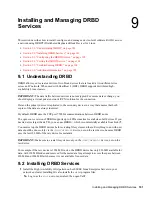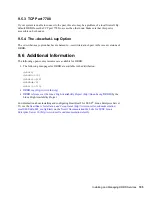
Installing and Managing DRBD Services
9
no
vd
ocx
(e
n)
6 Ap
ril 20
07
101
9
Installing and Managing DRBD
Services
This section describes how to install, configure, and manage a device-level software RAID 1 across
a network using DRBD* (Distributed Replicated Block Device) for Linux.
Section 9.1, “Understanding DRBD,” on page 101
Section 9.2, “Installing DRBD Services,” on page 101
Section 9.3, “Configuring the DRBD Service,” on page 102
Section 9.4, “Testing the DRBD Service,” on page 103
Section 9.5, “Troubleshooting DRBD,” on page 104
Section 9.6, “Additional Information,” on page 105
9.1 Understanding DRBD
DRBD allows you to create a mirror of two block devices that are located at two different sites
across an IP network. When used with HeartBeat 2 (HB2), DRBD supports distributed high-
availability Linux clusters.
IMPORTANT:
The data traffic between mirrors is not encrypted. For secure data exchange, you
should deploy a virtual private network (VPN) solution for the connection.
Data on the primary device is replicated to the secondary device in a way that ensures that both
copies of the data are always identical.
By default, DRBD uses the TCP port 7788 for communications between DRBD nodes.
The open source version of DRBD supports up to 4 TB as maximal overall size of all devices. If you
need a device larger than 4 TB, you can use DRBD+, which is commercially available from Linbit*.
You must set up the DRBD devices before creating file systems on them. Everything to do with user
data should be done solely via the
/dev/drbd<n>
device, not on the raw device, because DRBD
uses the last 128 MB of the raw device for metadata.
IMPORTANT:
Make sure to create file systems only on the
/dev/drbd<n>
device, not on the
raw device.
For example, if the raw device is 1024 MB in size, the DRBD device has only 896 MB available for
data, with 128 MB hidden and reserved for the metadata. Any attempt to access the space between
896 MB and 1024 MB fails because it is not available for user data.
9.2 Installing DRBD Services
1
Install the High Availability (HA) pattern on both SUSE Linux Enterprise Servers in your
networked cluster. Installing HA also installs the
drbd
program files.
1a
Log in as the
root
user or equivalent, then open YaST.
Содержание LINUX ENTERPRISE SERVER 10 - STORAGE ADMINISTRATION GUIDE 7-2007
Страница 4: ...novdocx en 6 April 2007...
Страница 30: ...30 SLES 10 Storage Administration Guide novdocx en 6 April 2007...
Страница 42: ...42 SLES 10 Storage Administration Guide novdocx en 6 April 2007...
Страница 58: ...58 SLES 10 Storage Administration Guide novdocx en 6 April 2007...
Страница 90: ...90 SLES 10 Storage Administration Guide novdocx en 6 April 2007...
Страница 100: ...100 SLES 10 Storage Administration Guide novdocx en 6 April 2007...
Страница 106: ...106 SLES 10 Storage Administration Guide novdocx en 6 April 2007...






















